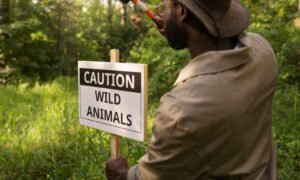Step into the enchanting world of wildlife photography, where every click captures mesmerizing moments of untamed beauty and raw emotions. In this captivating blog post, we delve deep into the lens to unravel the hidden significance behind these breathtaking snapshots. Prepare to embark on a journey that transcends mere visual pleasure as we explore how wildlife photography serves as a powerful tool for conservation, education, and inspiring awe in our hearts. Embark with us on this exhilarating expedition through nature’s wonders!
Introduction to Wildlife Photography
Wildlife photography is a specialized genre of photography that focuses on capturing images of animals and their natural habitats. It requires skill, patience, and an understanding of the behavior of different species in order to capture stunning and captivating photographs.
The popularity of wildlife photography has grown significantly in recent years, as more people are becoming interested in conservation and preserving the beauty of our natural world. With advancements in technology, it has become easier for amateur photographers to capture high-quality images of wildlife without disrupting their natural behaviors.
The purpose and significance of wildlife photography
The art of wildlife photography has been gaining popularity over the years, with advancements in technology making it more accessible to people from all walks of life. But what exactly is the purpose and significance of capturing images of animals in their natural habitat? In this section, we will delve deeper into why wildlife photography matters and how it contributes to our understanding and appreciation of the natural world.
Firstly, the primary purpose of wildlife photography is to document and showcase the diversity and beauty of different species in their natural environments. These photographs offer a glimpse into the lives of animals that most people may never have the opportunity to see in person. They allow us to witness intimate moments, behaviors, and interactions between these creatures that would otherwise go unnoticed.
Moreover, through these images, we can also learn about different ecosystems and their inhabitants. Wildlife photographers often spend long hours observing animals in their habitats, which allows them to capture unique shots that provide insight into animal behavior and their role in maintaining a balanced ecosystem. This information is invaluable for conservation efforts as it helps us understand how human activities impact these delicate ecosystems.
Additionally, wildlife photography plays a crucial role in raising awareness about conservation issues. With many species facing threats such as habitat destruction, poaching, and climate change, these photographs serve as a visual reminder of why we must protect our planet’s precious biodiversity. They can evoke strong emotions within viewers and inspire them to take action towards preserving these animals’ habitats.
Furthermore, wildlife photography also serves as a tool for education. These images can be used by researchers and scientists to study animal behavior or educate students about different species’ characteristics and habitats. Many nature magazines or documentaries rely on stunning wildlife photographs to engage their audience while educating them about various environmental issues.
Wildlife photography has significant artistic value. The technical skills required to capture an excellent shot are no less than those needed for any other genre of photography. It takes patience, creativity, knowledge about lighting and composition, and a deep understanding of the animals’ behavior to capture a perfect shot. These images can be appreciated not just for their documentary value but also for their aesthetic appeal.
How wildlife photography can raise awareness and promote conservation efforts
Wildlife photography is not just about capturing beautiful images of animals in their natural habitat. It also plays a crucial role in raising awareness and promoting conservation efforts. In this section, we will explore how wildlife photography can make a positive impact on the environment and the species it showcases.
Firstly, wildlife photography provides a visual representation of the diversity and beauty of our planet’s flora and fauna. These images serve as powerful tools to engage people and evoke emotions toward these creatures. When people see stunning photographs of endangered species or breathtaking landscapes, they are more likely to feel connected to them and develop a sense of responsibility towards protecting them.
Moreover, wildlife photographers often spend long hours observing animals in their natural habitats, learning about their behavior patterns, and capturing unique moments. This process allows them to gain firsthand knowledge about these species’ struggles and the threats they face due to human activities such as deforestation, pollution, poaching, etc. By sharing these insights through their photographs, they can educate people about the impact of human actions on wildlife.
Many conservation organizations use wildlife photography as a means to promote their cause. They collaborate with talented photographers who capture compelling images that showcase the importance of preserving nature’s balance for both humans and animals. These photos are then used in various campaigns and exhibitions to raise awareness among audiences worldwide.
In addition to raising awareness among the general public, wildlife photography also has an impact on policymakers and decision-makers. The photographs serve as evidence of environmental degradation caused by human activities, making it difficult for authorities to ignore or deny the need for urgent conservation efforts.
By showcasing the beauty and fragility of nature through their lenses, wildlife photographers inspire others to appreciate these wonders themselves. This appreciation can result in changes in behavior towards more sustainable practices that benefit both humans and animals.
Wildlife photography is much more than just taking pictures; it has significant potential to raise awareness and promote conservation efforts globally. Through its ability to connect people with nature and evoke emotions, it can inspire individuals to take action towards preserving our planet’s biodiversity. As the saying goes, “a picture is worth a thousand words,” and in this case, it can make a significant impact on the future of wildlife conservation.
Conclusion
Photography is a powerful medium to tell stories, and wildlife photography has the ability to tell the stories of our planet’s diverse flora and fauna. Through its captivating images, it can raise awareness, educate, and inspire action towards conservation efforts. As photographers continue to explore and document the natural world, their work will play a crucial role in preserving our planet’s biodiversity for future generations.



































